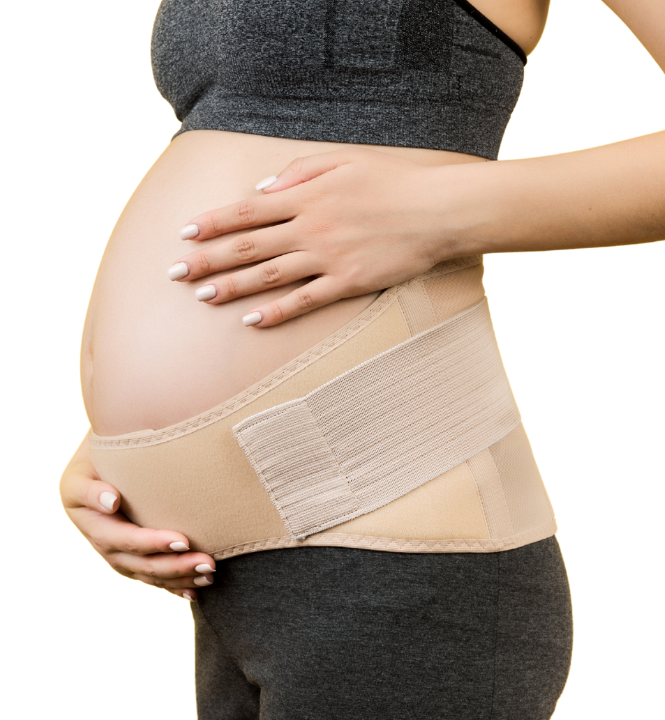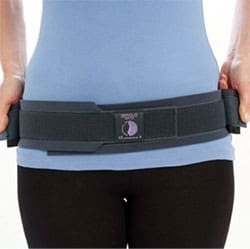Top Clinical Pearls for Lumbar Supports
Evidence-based chiropractors employ data to establish treatment algorithms. But what happens when that data changes? While we may have performed due diligence to develop a management protocol, new research will likely change that protocol over time. The best example would be how, in the past decade(s), the management of chronic tendinopathy has flipped from suppressing inflammation (tendonitis), toward generating a controlled inflammatory response (tendinopathy).
Providing “best practices” requires continual testing and evolution. But when was the last time you questioned the utility of everyday practice? For me, this occurred last week, when a long-time patient told me how much better she felt after her physiatrist prescribed a lumbar support belt. My long-held belief was that lumbosacral support belts had value in isolated instances… but I needed to know- was my belief still correct, or had new literature surpassed my understanding?
This week’s blog will highlight the most up-to-date evidence on four types of lumbosacral supports, then provide clinical pearls for indications, contraindications, and implementation -including a live video demonstration.
Earlier studies confirmed that lumbar belts might not help to prevent back problems. (28,29) But does current data show any utility for the management of back pain? Here’s a quick summary of the latest evidence on four lumbosacral supports.
1. Elastic Lumbar Support Belts
“Five of the six randomized controlled trials were of good quality, with all of them showing the use of lumbar support usually reducing discomfort and improving quality of life in individuals with low back pain. The prescription for wearing lumbar support for 6-8 hours per day for at least one month showed positive results.” (1)
2019 Journal of Health & Allied Sciences Systematic Review
Mechanical Actions
Elevate intraabdominal pressure (2,3)
Decrease lordosis (4)
Reduce trunk range of motion regionally and segmentally (4,5)
Decrease lumbosacral compressive force and spinal load (6-8)
Decrease intradiscal pressure (9)
Protect from soft tissue creep (10)
Clinical Effects
Reduce muscle fatigue (3)
Decrease pain intensity and functional impairment (2,5,11,12)
Decrease pharmaceutical consumption (11,12)
Over 80% of stenosis patients wearing a lumbar belt report >30% improvement in walking distance (13)
Improvement correlates with compliance (14)
No negative effect for long-term use (6 months) (15)
Typical Indications
Acute or sub-acute LBP
Segmental instability
Uncomplicated compression fracture
Stenosis
Clinical Considerations
Wear the support over thin, breathable clothes
May be more effective than rigid braces for chronic LBP (4)
Patients should avoid wearing elastic braces at night
Contraindications include significant hypertension, as the brace increases blood pressure (16)
2. Rigid Lumbosacral Orthosis (LSO)
Mechanical Actions
Added trunk stiffness over elastic braces (17)
Improved postural control (18)
According to BCBS of North Carolina, LSO brace medical necessity includes (19):
“To reduce pain by restricting mobility of the trunk”
“To facilitate healing following an injury to the spine or related soft tissues”
“To support weak spinal muscles and/or a deformed spine”
Clinical Effects
Reduce muscle fatigue (3)
Decrease pain intensity and functional impairment (2,5,11,12)
Typical Indications:
Instability
Spondylolysis
Degenerative spondylolisthesis
Post-surgical LBP
Clinical Considerations
Typically more expensive than elastic brace options
May be more uncomfortable, resulting in lower compliance
3. Pregnancy Support Belt
“The study concluded that wearing maternity support garments during pregnancy could have beneficial effects in women such as LBP and pelvic girdle pain alleviation, improvement of functionality and mobility, and reduction of risk of fall during pregnancy” (20)
2019 Journal of Pregnancy Systematic Review
Mechanical Actions
Supports the abdomen and lower back of pregnant women (20)
Clinical Effects
(Limited) evidence suggests symptomatic benefit (21-24)
Alleviation of LBP and pelvic girdle pain (20)
Improvement of functionality and mobility with reduction of fall risk (20)
Typical Indications
Pregnancy-related LBP
Clinical Considerations
Adverse effects reported include fetal heart rate changes, and skin irritation (21)
Providers should check with the patient’s Ob/GYN before dispensing
4. Sacroiliac Support Belt
“Pelvic belts improve health-related quality of life and are potentially attributed to decreased SIJ-related pain. Pelvic belts may therefore be considered as a cost-effective and low-risk treatment of SIJ pain.” (25)
Mechanical Actions
Decrease motion around the SI joint transverse axis (27)
Decrease ligamentous strain (27)
Decreased rectus femoris activity (25)
Clinical Effects
Decrease pain and improve function (25)
Improve gait cadence and velocity (25)
Improve postural steadiness during locomotion (25)
Typical Indications
Sacroiliac dysfunction, particularly hypermobility
Clinical Considerations
Clinicians may screen patients who are likely candidates to benefit from an SI belt by applying a compressive force through both iliac crests while the patient walks, i.e., simulate the belts compressive force.
Avoid prolonged hip compression in patients with co-existing gluteal tendinopathy or greater trochanteric pain syndrome.
In conclusion, current literature indicates that lumbosacral support belts are safe with few side effects. (26) These orthoses are not necessarily protective (28-30); however, they may help manage symptoms. And contrary to popular opinion, long-term use will not likely cause muscle weakness. (15)
Do you have your own tips for support belts? We would love to hear them. Leave your comments to help make this blog better!
Start your free trial today to see why more than 1,000 of the world’s top providers trust ChiroUp to automate their delivery of clinical excellence.
-
Paungmali A. Effectiveness of Lumbar Support in Management of Low Back Pain: A Systematic Review. Online Journal of Health and Allied Sciences. 2019 Jan 30;17(4). Link
Anders C, Hübner A. Influence of elastic lumbar support belts on trunk muscle function in patients with non-specific acute lumbar back pain. PLoS One. 2019;14(1):e0211042. Published 2019 Jan 24. doi:10.1371/journal.pone.0211042 Link
Mokhtarinia H, Ghamary J, Maleki-Ghahfarokhi A, Asgari M, Gabel CP, Parnianpour M. The new "Tehran Back Belt": Design then testing during a simulated sitting task improved biomechanical spine muscle activity. Health Promot Perspect. 2019;9(2):115–122. Published 2019 May 25. doi:10.15171/hpp.2019.16 Link
Kang JI, Kwon HM, Jeong DK, Choi H, Moon YJ, Park JS. The effects on postural control and low back pain according to the types of orthoses in chronic low back pain patients. J Phys Ther Sci. 2016;28(11):3074–3077. doi:10.1589/jpts.28.3074 Link
Cholewicki J, McGill KC, Shah KR, Lee AS. The effects of a three-week use of lumbosacral orthoses on trunk muscle activity and on the muscular response to trunk perturbations. BMC Musculoskelet Disord. 2010;11:154. Published 2010 Jul 7. doi:10.1186/1471-2474-11-154 Link
Ludvig D, Preuss R, Larivière C. The effect of extensible and non-extensible lumbar belts on trunk muscle activity and lumbar stiffness in subjects with and without low-back pain. Clinical Biomechanics. 2019 Jul 1;67:45-51. Link
Chihara T, Nishijima U, Moriya I, Seo A, Hatano H, Yamada H. Optimum design of a lumber support belt to reduce the physical workload of the low back. Journal of Advanced Mechanical Design, Systems, and Manufacturing. 2016;10(1):JAMDSM0012-. Link
Azadinia F, Takamjani EE, Kamyab M, Parnianpour M, Cholewicki J, Maroufi N. Can lumbosacral orthoses cause trunk muscle weakness? A systematic review of literature. The Spine Journal. 2017 Apr 1;17(4):589-602. Link
Hagiwara Y, Yabe Y, Yamada H, et al. Effects of a wearable type lumbosacral support for low back pain among hospital workers: A randomized controlled trial. J Occup Health. 2017;59(2):201–209. doi:10.1539/joh.16-0203-OA Link
Larivière C, Caron JM, Preuss R, Mecheri H. The effect of different lumbar belt designs on the lumbopelvic rhythm in healthy subjects. BMC musculoskeletal disorders. 2014 Dec;15(1):307. Link
Calmels P, Queneau P, Hamonet C, Le Pen C, Maurel F, Lerouvreur C, Thoumie P. Effectiveness of a lumbar belt in subacute low back pain: an open, multicentric, and randomized clinical study. Spine. 2009 Feb 1;34(3):215-20. Link
Lanhers C, Boutevillain L, Pereira B, Coudeyre E. Lumbar support and nonspecific low back pain: Evidence for daily practice. Annals of physical and rehabilitation medicine. 2016 Sep 1;59:e29. Link
Ammendolia C, Rampersaud YR, Southerst D, Ahmed A, Schneider M, Hawker G, Bombardier C, Côté P. Effect of a prototype lumbar spinal stenosis belt versus a lumbar support on walking capacity in lumbar spinal stenosis: a randomized controlled trial. The Spine Journal. 2019 Mar 1;19(3):386-94. Link
Hekmatfard M, Sanjari MA, Maroufi N, Saeedi H, Ebrahimi E, Behtash H. A Preliminary Study of the Objective Measurement of Compliance Rates for Semirigid Lumbar-Support Use in Patients with Chronic Nonspecific Low Back Pain: How Important Is the Compliance Rate?. Asian Spine J. 2017;11(5):748–755. doi:10.4184/asj.2017.11.5.748 Link
Takasaki H, Miki T. The impact of continuous use of lumbosacral orthoses on trunk motor performance: a systematic review with meta-analysis. The Spine Journal. 2017 Jun 1;17(6):889-900. Link
Rafacz W, McGill SM. Wearing an abdominal belt increases diastolic blood pressure. Journal of occupational and environmental medicine. 1996 Sep 1;38(9):925-7. Link
Morrisette DC, Cholewicki J, Logan S, Seif G, McGowan S. A randomized clinical trial comparing extensible and inextensible lumbosacral orthoses and standard care alone in the management of lower back pain. Spine (Phila Pa 1976). 2014;39(21):1733–1742. doi:10.1097/BRS.0000000000000521 Link
Mi J, Ye J, Zhao X, Zhao J. Effects of lumbosacral orthoses on postural control in individuals with or without non-specific low back pain. European Spine Journal. 2018 Jan 1;27(1):180-6. Link
BCBS of North Carolina. Accessed online 10/8/19 from: https://www.bluecrossnc.com/sites/default/files/document/attachment/services/public/pdfs/bluemedicare/medicalpolicy/Orthotics_lumbar_sacral_thoracic_lumbar_sacral.pdf
2 Quintero Rodriguez C, Troynikov O. The Effect of Maternity Support Garments on Alleviation of Pains and Discomforts during Pregnancy: A Systematic Review. J Pregnancy. 2019;2019:2163790. Published 2019 Aug 1. doi:10.1155/2019/2163790 Link
Ho SS, Yu WW, Lao TT, Chow DH, Chung JW, Li Y. Effectiveness of maternity support belts in reducing low back pain during pregnancy: a review. Journal of clinical nursing. 2009 Jun;18(11):1523-32. Link
van Benten E, Pool J, Mens J, Pool-Goudzwaard A. Recommendations for physical therapists on the treatment of lumbopelvic pain during pregnancy: a systematic review. journal of orthopaedic & sports physical therapy. 2014 Jul;44(7):464-A15. Link
Kordi R, Abolhasani M, Rostami M, Hantoushzadeh S, Mansournia MA, Vasheghani-Farahani F. Comparison between the effect of lumbopelvic belt and home based pelvic stabilizing exercise on pregnant women with pelvic girdle pain; a randomized controlled trial. J Back Musculoskelet Rehabil. 2013; 26: 133– 139. http://dx.doi.org/10.3233/BMR-2012-00357[Crossref] [Medline] , [Google Scholar]
Nilsson-Wikmar L, Holm K, Oijerstedt R, Harms-Ringdahl K. Effect of three different physical therapy treatments on pain and activity in pregnant women with pelvic girdle pain: a randomized clinical trial with 3, 6, and 12 months follow-up postpartum. Spine (Phila Pa 1976). 2005; 30: 850– 856. [Crossref] [Medline] , [Google Scholar]
Hammer N, Möbius R, Schleifenbaum S, et al. Pelvic Belt Effects on Health Outcomes and Functional Parameters of Patients with Sacroiliac Joint Pain [published correction appears in PLoS One. 2015;10(10):e0140090]. PLoS One. 2015;10(8):e0136375. Published 2015 Aug 25. doi:10.1371/journal.pone.0136375 Link
Schott C, Zirke S, Schmelzle JM, Kaiser C, i Fernández LA. Effectiveness of lumbar orthoses in low back pain: Review of the literature and our results. Orthopedic reviews. 2018 Dec 6;10(4). Link
Sichting F, Rossol J, Soisson O, Klima S, Milani T, Hammer N. Pelvic belt effects on sacroiliac joint ligaments: a computational approach to understand therapeutic effects of pelvic belts. Pain Physician. 2014;17(1):43-51. Link
Jellema P, van Tulder MW, van Poppel MN, Nachemson AL, Bouter LM. Lumbar supports for prevention and treatment of low back pain: a systematic review within the framework of the Cochrane Back Review Group. Spine. 2001;26(4):377–386. doi: 10.1097/00007632-200102150-00014. Link
van Duijvenbode IC, Jellema P, van Poppel MN, van Tulder MW. Lumbar supports for prevention and treatment of low back pain. Cochrane Database Syst Rev.2008. p. CD001823
Steffens D, Maher CG, Pereira LS, Stevens ML, Oliveira VC, Chapple M, Teixeira-Salmela LF, Hancock MJ. Prevention of low back pain: a systematic review and meta-analysis. JAMA internal medicine. 2016 Feb 1;176(2):199-208. Link




